Sometimes I get an idea that I think may be worth something, maybe not much, but something. But then I forget it. Better write it down, here.
2017-12-10
Use of generative adversarial networks for 3-d protein folding
Use generative adversarial networks directly for 3-d protein folding. The discriminator network would try to recognize valid structures and the generative network would try to create, given protein amino acid sequences, structures that the discriminator can't tell from known valid structures. The Protein Data Bank has about 100 000 pieces of crystallographic and other structures that can be used as training data. The structure representation could be randomly rotated coordinates of the backbone atoms, or (simulated) electron density.
2017-12-04
Wireless recording microphones
Wireless microphones that would store audio into flash memory in each microphone, and when stored in their storage box after a recording session, would recharge wirelessly and upload the data wirelessly to a central storage.
2017-09-07
Automated safe pledging waits for critical mass
A service that lets people pledge something on the condition that enough people do the same. One application would be getting researchers to pledge not to cite research articles submitted after critical mass has been reached, unless the article is open access, forcing traditional publishing out of the waters.
2017-09-07
Blockchain-based real-time taxation
A currency blockchain where the amount of currency in any wallet is not the same as it was since the last transaction concerning the account, but has decayed exponentially with time. If another transaction takes place, the amount of currency will be calculated from the decay curve plus the transaction. The amount reduced by the decay has in the meanwhile gone to the wallet of the state, as real-time tax.
2017-09-05
Cushion/mattress to sit/sleep on with pumped compartments
To people that sit a lot, a cushion that has an interleaved pattern of air bags consisting of two compartments, with a pump that pumps back and forth between the compartments. This will increase circulation in the butt and probably reduce pain related to poor circulation or pressure on nerves. Prior art that should be used more commonly with elderly people:
2013-11-29
Fractal spring reverb
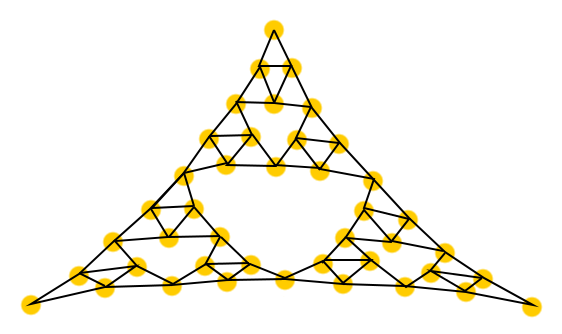
Similar to fractal antennas, springs in a spring reverb could be arranged so that the frequency response is self-similar (flat) over multiple octaves. The springs could be welded together or a drop of glue could be added at each connection to prevent rattling.
2013-07-17
Foaming detection for microwave ovens
A camera integrated into the microwave oven that detects when the food starts to foam, and reduces power accordingly.
2012-07-15
Paintbrush with weakly magnetic bristles
When painting, sometimes a few bristles of the paintbrush stick out to a random direction, spreading paint to unintended places. If the bristles are made of a weakly magnetic material, then they will stick together as a single bunch.
2012-02-09
Psychoacoustical windowing functions
A windowing function that has been optimized for minimum audible sidelobes and for good time-frequency localization. Windowing a sinusoid spreads its spectrum by convolving it with the spectrum of the windowing function. If the resulting wavelet is listened to, the main lobe spectrally masks the side lobes to some extent. Making a reasonable assumption about the sound pressure level of the sinusoid, knowing that audio in general decays 3 dB per octave, spectral masking curves can be used to calculate whether the resulting sidelobes are above the hearing threshold.
2012-01-26
Never late clock
Instead of time, the "never late" clock shows time plus a uniformly random increment picked from a configurable interval of 0 to 15 minutes or so. The user must always act as if the time was already what the clock shows plus 15 minutes, helping the user to not be late.
2011-12-30
Adjustable frequency and stroke length mechanical oscillator
The first motor adjusts stroke length and the second motor determines the frequency. This could be used as a seismic vibrator in reflection seismology.
2011-11-01
Eye trainer
It may be that near-sightedness (myopia) is caused partially by the eyes not being exercised to focus at different distances, for example when one reads a lot or uses a computer a lot. To alleviate this, computer displays could be modified optically in such a way that the user has to focus at distance. Or special glasses could be worn that continuously modify the focusing distance in order to train the eyes.
2011-10-05
Dull-lustre separation in photography
A linearly polarizing filter is attached to a digital camera lens and slowly rotated half a circle while filming a video, keeping the camera, the subject and lightning steady. The video is processed to find the maximum and minimum intensity value at each pixel. The mimimum values give the "dull" component of the image and the differences between the maximum and minimum values gives the "lustre" component of the image. These can be combined linearly to get the wanted visual effect. Because maximums tend to come and go smoothly by time, the effect of sensor noise can be reduced by taking a temporal quadrating polynomial fit over a few successive frames, and by using the value at the peak of the polynomial (if it is within those frames) as a candidate for the maximum.
2011-09-09
Wick loop pump
A loop of water-absorbent sponge-like rope, made from material such as wool, sucks in water from a well. The loop is rotated and up above the ground the loop is squeezed between two wheels, releasing the water.
2011-07-16
Oil brush jar
For use in kitchens, for storing and spreading of oil, on bread or whatnot. The brush has natural cellulose fibers that absorb oil. The brush is integrated into the lid. The preferred material is glazed clay or porcelaine.
2011-05-18
Doomsday light-spheres.
Could there exist frequent phenomena that spread indefinitely in all directions at the speed of light and destroy all matter in their path?
In many-worlds we would never see them, because as soon as the phenomenon becomes visible to us, the doomsday front swipes us away. From that point of view the phenomena could be a valid consequence of natural laws, consistent with our observed reality.
It has been speculated that we might live in a false vacuum that could decay into a lower-energy true vacuum. The bubble of true vacuum would spread very nearly at the speed of light. If there is an energy barrier separating the true and the false vacuum, tunneling through the barrier or by high-energy particle collisions might cause nucleation of the bubble.
Such collisions take place naturally due to cosmic rays and artificially in particle accelerators such as LHC.
So is LHC a doomsday device that initiates doomsday at a high probability at each experiment carried out? I think there is a way to answer the question:
1. Estimate the probability at which the LHC project would fail to carry out any experiments. This would include the risk of natural disasters that destroy the facility, wars, recurring technical difficulties, and budget cuts.
2. Decide on an acceptable increase to the first probability. It should be a very small number, but it is OK if it is larger than the first.
3. Pick a quantum random number that is so large that each of its values has a probability equal to the number from step 2.
4. If the quantum random number equals let's say the first decimals of pi, discontinue LHC forever.
After the planned life-time of LHC, if the probability that LHC initiates doomsday is large enough, the observed history will be such that the quantum random number was equal to the number we were comparing it to, and that we discontinued LHC. If LHC does not initiate doomsday, it becomes very unlikely to observe that history. It may also be that the other scenarios that prevent experiments at LHC are realized, but hopefully the probability of those is vanishingly small.
2011-04-06
Flashing display for visualization of multi-spectral images. The human vision has three color channels as demonstrated by the adequacy of red/green/blue additive primaries. Multi-spectral imaging produces data that can have much more channels, and is hard to scale to three channels for display. Often these images are stationary still images. In case of video, the scene probably changes slowly. This enables displaying of additional information by transforming it into temporal signals, such as flashing, oscillation and movement.
2010-12-08
Posture-correcting device. A thin curvature measurement strip (strain gauge) is attached vertically against the skin of the back or the neck along the spine. A microprocessor makes an alarm when the curvature exceeds a set threshold that indicates bad posture. The alarm may be vibrational, so that it will not cause disturbance or unwanted attention. The alarm helps the user to notice and then correct bad posture. Alternative sensing methods would be distance measurement by audio or by radio frequencies (if those are feasible), a number of 3-axis accelerometers, or a video camera and smart algorithms to figure out the posture from the video images.
2010-10-18
High-mutation-frequency plasmids. Directed evolution experiments could benefit from error-prone DNA polymerases that copy only the target gene, while the rest of the genome would be copied as usual, in high fidelity. How exactly to do this, I don't know. It would probably involve a separate high-error-rate DNA polymerase.
2010-05-18
A theory on how molecules inside a cell manage to be in the part of the cell where they are needed. If macromolecules A and B bind to each other and B and C also bind to each other, and the two binding reactions need not compete with one another, then obviously A and C will also end up close together, via B. This must be a very common way to create a tight organization between macromolecules. But what about when a more loose organization is required, let's say when the rather freely diffusing tRNA's are needed where translation takes place. It seems unlikely that the contents of a cell would be an inefficient homogeneous porridge of macromolecules. Perhaps affinities between macromolecules brings about organization. To describe the affinities between N species of macromolecules, one would need at least an N x N triangular matrix of affinity constants. It would be interesting to simulate such a system, and to see if compartmentalization takes place by itself without boundaries. If a macromolecule of an unknown purpose is found to have affinity to several components of a cellular process, then the guess can be made that it probably contributes to the process somehow. These affinities probably wouldn't need to be very strong. Some types of metabolic and transport systems could perhaps be shown to be more effective in an internally organized cell.
2010-04-07
A directional microphone that is a 3D configuration of multiple omnidirectional microphone elements. The signals from the different elements are made to be in phase by using digital delay lines. The microphone can also be made resistant to turbulences caused by wind by temporarily muting the affected elements, and by surrounding each with a chassis that protects it against wind from a certain direction. The direction would be different for each element.
2010-02-24
A method for training artificial neural networks to generate missing data within a variable context. As the idea is hard to put in a single sentence, I will use an example:
An image may have missing pixels (let's say, under a smudge). How can one restore the missing pixels, knowing only the surrounding pixels? One approach would be a "generator" neural network that, given the surrounding pixels as input, generates the missing pixels.
But how to train such a network? One can't expect the network to exactly produce the missing pixels. Imagine, for example, that the missing data is a patch of grass. One could teach the network with a bunch of images of lawns, with portions removed. The teacher knows the data that is missing, and could score the network according to the root mean square difference (RMSD) between the generated patch of grass and the original data. The problem is that if the generator encounters an image that is not part of the training set, it would be impossible for the neural network to put all the leaves, especially in the middle of the patch, in exactly the right places. The lowest RMSD error would probably be achieved by the network filling the middle area of the patch with a solid color that is the average of the color of pixels in typical images of grass. If the network tried to generate grass that looks convincing to a human and as such fulfills its purpose, there would be an unfortunate penalty by the RMSD metric.
My idea is this (see figure below): Train simultaneously with the generator a classifier network that is given, in random or alternating sequence, generated and original data. The classifier then has to guess, in the context of the surrounding image context, whether the input is original (1) or generated (0). The generator network is simultaneously trying to get a high score (1) from the classifier. The outcome, hopefully, is that both networks start out really simple, and progress towards generating and recognizing more and more advanced features, approaching and possibly defeating human's ability to discern between the generated data and the original. If multiple training samples are considered for each score, then RMSD is the correct error metric to use, as this will encourage the classifier network to output probabilities.

2010-02-18
A graphic design methodology that projects a 2D pattern of silhouettes as objects onto a 3D landscape and renders the scene using 3D methods. For example, a set of squares is turned into a city of facades on a landscape, perhaps even with perspective.
2010-01-27
Exact coordinates for computer aided design (CAD). If a CAD program stores coordinates internally as floating point, then movement of objects such as rotations will accumulate error in the inexact numerical coordinates. This could result in two points not coinciding when they should, if they were subjected to different transformations. Perhaps the only way to avoid this would be to store the coordinates exactly, including things like square roots and such in a formula type of an expression. When possible, the expression would be simplified. For example sqrt(2)*sqrt(2) would become 2. The drawback is that everything would become slower.
2010-01-13
Terminator yeast for carbonation of bottled beverages. Carbonation of bottled beverages by yeast has the problem that the yeast will use up all the sugar, and usually it would be good to leave at least some sweetness. So, engineer a yeast that stops fermenting after, let's say, a number of growth cycles. Additionally, to reduce the amount of sediment, the yeast could be made to waste energy instead of using it for growth. The trigger of this could be related to growth cycles. The best would be detection of pressure, stopping the metabolism of the yeast when there is enough pressure in the bottle. A mechanism for pressure sensing could perhaps be evolved by switching between different food sources and by signaling the switch beforehand by a pressure change. Alternatively the trigger could be CO$_2$ concentration. Reading a bit on the topic, some researchers have produced cold-sensitive strains of baker's yeast by using nystatin, which presumably kills growing yeast cells.
2009-10-04
Singing brakes for bicycles. By etching sound wave patterns into the rim, the rim brake could be made to produce tones, maybe even arbitrary sounds.
2009-09-12
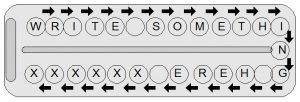
This is intended as an artistic effect, not actual labeling of pills. Uh, sounds like such an obvious idea that someone probably already used it.
2009-08-30
Create genetically manipulated trees with branches in line and only on two sides, to get more knotless lumber
- Does the tree twist and loose the polarity? Now this is a possibility.
- How to do it? Should look into developmental biology.
- Does the tree get enough light? The branches can branch also horizontally so it wouldn't be just a flat tree. And even if it's a flat tree it gets about 64 % of the light compared to a normal tree.
- Does it replace normal trees in the ecosystem? Unlikely, because it won't be as effective in collecting light as normal trees.
2007-10-26
A musical wind instrument with electro-acoustic feedback
- How is the feedback created? By a microphone and a small loudspeaker.
- How does one get different notes? The delay length is adjusted by the player by pressing keys.
- How is the feedback delay made? It is either an electronic/digital delay or an array of microphones is used.
- What if the speaker is of poor quality? Compensate for example by low-pass filtering. An adjustable filter would also allow coloration of the tone.
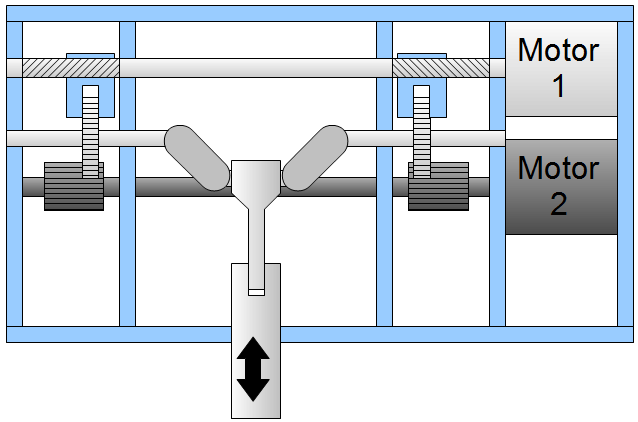
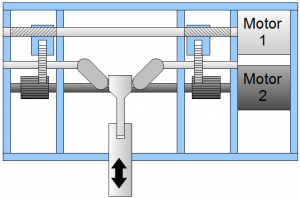
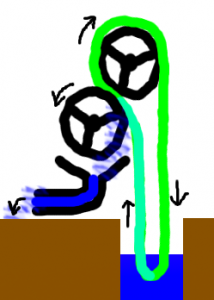
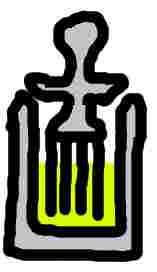
Concerning the genetically manipulated trees: What do you think about genetically manipulated trees, which are able to shine like fireflies in the darkness? We could save energy, no need for street lights anymore. They would need luciferin and luciferase, but it should be possible to transform them with both genes.
:D Not a bad idea, Silke! I wonder if the trees have the extra energy to be bright enough.
Your directional microphone from 2010-04-07 is a generalisation of the FIR filter and antenna arrays. I thought about it myself, but did not work on specific configurations. I’d probably start with an analysis software to show the effects and change coefficients and coordinates. Multi antenna radio direction finding has been done by a radio amateur I know. He worked with four antennas in a square. All signal processing was done in a DSP then.
BTW another thing I was thinking about was a didgeridoo-like instrument whose complete resonance section is simulated by software. It would require a good microphone and loudspeaker (probably in one device) and lowest delay signal processing. A physical “DC”-path would let the air flow through in a steady way. The big advantage is that the characteristics of the instrument could be changed any time. Is this idea similar to your one from 2007?
Beat,
Yeah, I also realized that it’s like a FIR filter and an antenna/radar array. In radars a planar array is usually used. Planar arrays have the advantage that if you want directionality, just point the array to the target and no delays are needed.
Your digeridoo idea sounds very similar! I actually started to build my instrument already. It’s shaped like a horn with a speaker closing the larger end, and microphones embedded inside the pipe in the narrow end. I’m having a difficult time with the natural resonances of the instrument. If I get the latency of the DSP board that I’m using short enough, perhaps I can cancel those. Or I might make both ends of the instrument open, with a gap between the speaker and the horn.
I like your adjustable stroke mechanism, I haven’t seen it done that way before. Good work.
Thanks Craig!